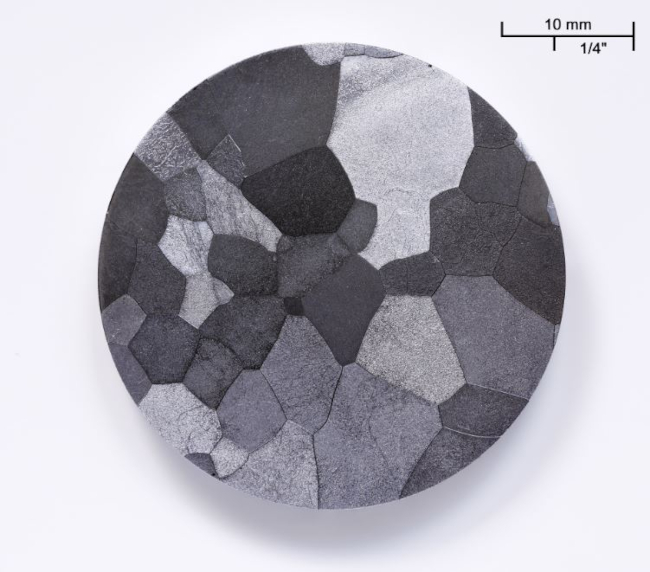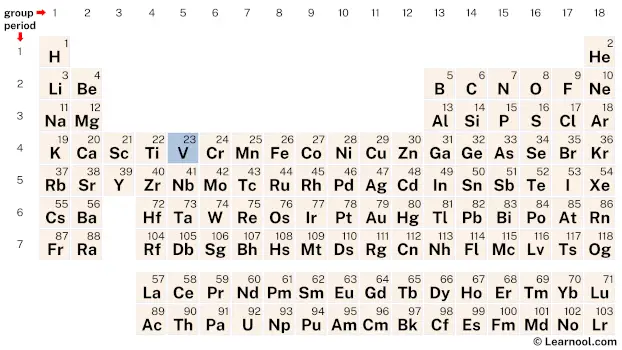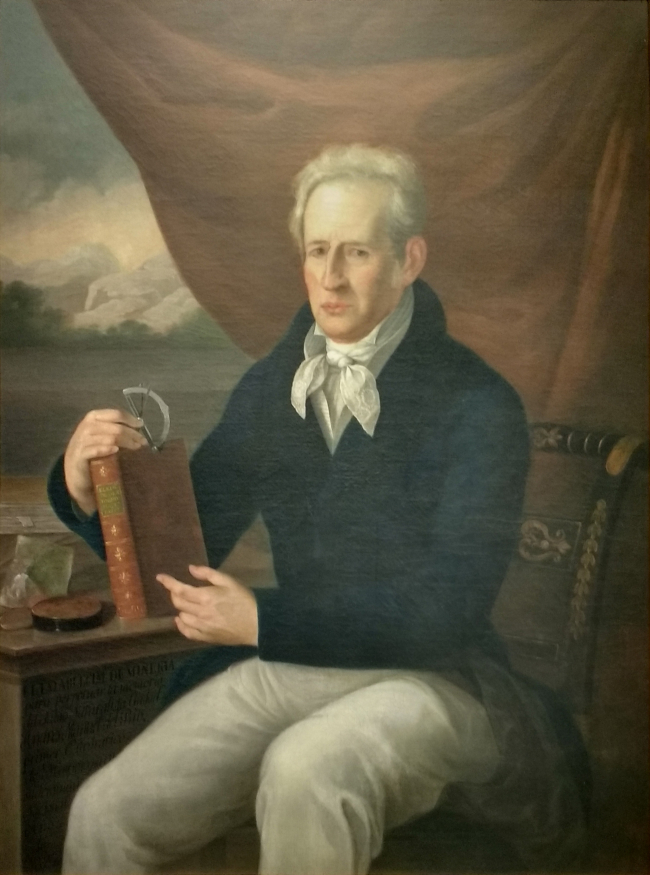
Vanadium (V) is a chemical element of the periodic table, located in the group 5 and the period 4, and has the atomic number 23. It is a hard, malleable, silvery-grey transition metal, which is named after “Vanadis”, the Scandinavian goddess Freyja. It is the 20th most abundant element on earth.
On periodic table
| group | ⇨ | 1 | 2 | 3 | 4 | 5 | 6 | 7 | 8 | 9 | 10 | 11 | 12 | 13 | 14 | 15 | 16 | 17 | 18 |
| period | ⇩ | ||||||||||||||||||
| 1 | 1 H  Hydrogen |
2 He  Helium |
|||||||||||||||||
| 2 | 3 Li  Lithium |
4 Be  Beryllium |
5 B  Boron |
6 C  Carbon |
7 N  Nitrogen |
8 O  Oxygen |
9 F  Fluorine |
10 Ne  Neon |
|||||||||||
| 3 | 11 Na  Sodium |
12 Mg  Magnesium |
13 Al  Aluminium |
14 Si Silicon |
15 P  Phosphorus |
16 S  Sulfur |
17 Cl  Chlorine |
18 Ar  Argon |
|||||||||||
| 4 | 19 K  Potassium |
20 Ca  Calcium |
21 Sc  Scandium |
22 Ti  Titanium |
23 V Vanadium |
24 Cr  Chromium |
25 Mn  Manganese |
26 Fe  Iron |
27 Co  Cobalt |
28 Ni  Nickel |
29 Cu  Copper |
30 Zn  Zinc |
31 Ga  Gallium |
32 Ge  Germanium |
33 As  Arsenic |
34 Se  Selenium |
35 Br  Bromine |
36 Kr  Krypton |
|
| 5 | 37 Rb  Rubidium |
38 Sr  Strontium |
39 Y  Yttrium |
40 Zr  Zirconium |
41 Nb  Niobium |
42 Mo  Molybdenum |
43 Tc  Technetium |
44 Ru  Ruthenium |
45 Rh  Rhodium |
46 Pd  Palladium |
47 Ag  Silver |
48 Cd  Cadmium |
49 In  Indium |
50 Sn  Tin |
51 Sb  Antimony |
52 Te  Tellurium |
53 I  Iodine |
54 Xe  Xenon |
|
| 6 | 55 Cs  Caesium |
56 Ba  Barium |
72 Hf  Hafnium |
73 Ta  Tantalum |
74 W  Tungsten |
75 Re  Rhenium |
76 Os  Osmium |
77 Ir  Iridium |
78 Pt  Platinum |
79 Au  Gold |
80 Hg  Mercury |
81 Tl  Thallium |
82 Pb  Lead |
83 Bi  Bismuth |
84 Po  Polonium |
85 At  Astatine |
86 Rn  Radon |
||
| 7 | 87 Fr  Francium |
88 Ra  Radium |
104 Rf  Rutherfordium |
105 Db  Dubnium |
106 Sg  Seaborgium |
107 Bh  Bohrium |
108 Hs  Hassium |
109 Mt  Meitnerium |
110 Ds  Darmstadtium |
111 Rg  Roentgenium |
112 Cn  Copernicium |
113 Nh  Nihonium |
114 Fl  Flerovium |
115 Mc  Moscovium |
116 Lv  Livermorium |
117 Ts  Tennessine |
118 Og  Oganesson |
||
| 57 La  Lanthanum |
58 Ce  Cerium |
59 Pr  Praseodymium |
60 Nd  Neodymium |
61 Pm  Promethium |
62 Sm  Samarium |
63 Eu  Europium |
64 Gd  Gadolinium |
65 Tb  Terbium |
66 Dy  Dysprosium |
67 Ho  Holmium |
68 Er  Erbium |
69 Tm  Thulium |
70 Yb  Ytterbium |
71 Lu  Lutetium |
|||||
| 89 Ac  Actinium |
90 Th  Thorium |
91 Pa  Protactinium |
92 U  Uranium |
93 Np  Neptunium |
94 Pu  Plutonium |
95 Am  Americium |
96 Cm  Curium |
97 Bk  Berkelium |
98 Cf  Californium |
99 Es  Einsteinium |
100 Fm  Fermium |
101 Md  Mendelevium |
102 No  Nobelium |
103 Lr  Lawrencium |
|||||
| – d block |
Vanadium is a d-block element, situated in the fifth column and the fourth row of the periodic table, denoted by the atomic number 23 and chemical symbol V.
Element information
 |
|
 |
|
| Origin of name | named after Vanadis, old Norse name for the Scandinavian goddess Freyja |
| Symbol | V |
| Atomic number (Z) | 23 |
| Atomic mass | 50.9415 u |
| Block | d-block |
| Group | 5 |
| Period | 4 |
| Classification | Transition metal |
| Atomic radius | 134 pm |
| Covalent radius | 153±8 pm |
| Melting point | 1910 ℃, 3470 ℉, 2183 K |
| Boiling point | 3407 ℃, 6165 ℉, 3680 K |
| Electron configuration | [Ar] 3d3 4s2 |
| Learn how to write: Vanadium electron configuration | |
| Electrons per shell | 2, 8, 11, 2 |
| Learn how to draw: Vanadium Bohr model | |
| Crystal structure | Body-centered cubic (bcc) |
| Phase at r.t | Solid |
| Density near r.t | 6.11 g/cm3 |
| Main isotopes | Vanadium-51 |
| Natural occurrence | Primordial |
| Oxidation state | +2, +3, +4, +5 |
| Electronegativity (Pauling scale) | 1.63 |
| Protons Neutrons Electrons |
23 28 23 |
| Learn how to find: Vanadium protons neutrons electrons | |
| CAS number | 7440-62-2 |
| Discovered by | Andrés Manuel del Río in 1801 |
History

Vanadium was discovered by the Spanish mineralogist Andrés Manuel del Río in 1801. He initially named it “panchromium,” but later realized that it was identical to a previously discovered element called “chromium.” The element was rediscovered in 1830 by the Swedish chemist Nils Gabriel Sefström while analyzing samples of iron ore from the Swedish county of Värmland. Sefström named the element after the goddess of beauty and fertility, Vanadis, from Norse mythology. Vanadium was isolated in metallic form in 1867 by Sir Henry Enfield Roscoe, who reduced vanadium pentoxide with hydrogen gas.
Vanadium has been used in various applications throughout history. In the early 20th century, vanadium was used in the production of high-quality steel alloys, including those used in the construction of the Ford Model T. During World War Ⅰ, vanadium was used in the production of armor plate and other military equipment. Today, vanadium is used in the production of a wide range of products, including steel, titanium alloys, and vanadium redox flow batteries.
Occurrence and production
Vanadium is found in over 65 minerals, including vanadinite, patronite, carnotite, and roscoelite. It is also found in crude oil, tar sands, and many types of coal. The metal is most commonly produced as a by-product of steelmaking, where iron ore is purified with coke and limestone in a blast furnace, and vanadium is collected in the form of an alloy called ferrovanadium. Vanadium can also be extracted from other sources, such as uranium ore, phosphate rock, and shale oil.
The majority of vanadium is produced from the processing of various iron ores, including magnetite (Fe3O4), hematite (Fe2O3), and ilmenite (FeTiO3). During the production of steel, small amounts of vanadium are added to improve the strength and toughness of the resulting alloy. This vanadium is typically recovered from the slag generated during the steelmaking process.
Another major source of vanadium is from the processing of petroleum residues, such as crude oil, tar sands, and bitumen. These materials contain trace amounts of vanadium, which can be extracted using a variety of techniques, including pyrometallurgical and hydrometallurgical processes. Pyrometallurgical processes involve heating the materials to high temperatures in the presence of oxygen, while hydrometallurgical processes use chemicals to dissolve the vanadium and separate it from other elements.
In recent years, new sources of vanadium have been explored, such as the extraction of vanadium from vanadium-bearing shale and the recovery of vanadium from fly ash generated by coal-fired power plants. These methods are still in the experimental stage and have yet to become commercially viable.
Properties
Physical properties
Vanadium is a silvery-gray, ductile metal with good corrosion resistance.
It has a relatively high melting point of 1910 ℃ and boiling point of 3407 ℃.
Vanadium has a density of 6.11 g/cm3, making it one of the densest transition metals.
Chemical properties
Vanadium is a reactive metal and readily forms compounds with a wide range of elements.
It has multiple oxidation states, with the most common ones being +2, +3, +4, and +5.
Vanadium forms many important compounds, including vanadium pentoxide (V2O5) and various vanadate salts.
Biological properties
Vanadium is an essential trace element for some organisms, including some species of bacteria and algae.
It has been shown to have insulin-mimetic properties and may play a role in glucose metabolism.
Vanadium can also be toxic at high concentrations and has been associated with certain health risks.
Applications
Steel production
Vanadium is primarily used as an alloying element in the production of high-strength steel. It is added to steel in small amounts to improve its strength, toughness, and resistance to corrosion and wear.
Energy storage
Vanadium is used in the production of vanadium redox batteries, which are a type of rechargeable flow battery used for large-scale energy storage. These batteries are used in renewable energy systems, grid energy storage, and other applications where large amounts of energy need to be stored and released.
Aerospace
Vanadium is used in the aerospace industry for its high strength-to-weight ratio and resistance to corrosion. It is used in the production of aircraft parts, such as landing gear, jet engines, and airframe components.
Chemicals
Vanadium is used in the production of various chemicals, including sulfuric acid, phthalic anhydride, and maleic anhydride. It is also used as a catalyst in the production of ethylene and other petrochemicals.
Medical
Vanadium has been found to have potential medical applications, including as an insulin mimetic and in the treatment of diabetes. It is also being studied for its potential anti-cancer properties.
Interesting facts
Vanadium has one stable isotope 51V and several radioactive isotopes.
Vanadium is a hard, silvery-gray metal that is used as an alloying element in steel and titanium alloys.
Vanadium has the ability to form compounds with a wide range of oxidation states, which makes it useful in the production of catalysts and pigments.
Vanadium is named after the Norse goddess Vanadis, who was known for her beauty and fertility.
Vanadium was used in the Manhattan Project to produce a high-strength alloy that was used in nuclear reactors.
Vanadium has been found to have potential medicinal properties, such as anti-tumor and anti-diabetic effects.
Vanadium dioxide is a material that exhibits a unique behavior known as a metal-insulator transition, which makes it useful in electronic devices.
Vanadium redox flow batteries are a type of rechargeable battery that uses vanadium ions to store energy.
Vanadium has been detected in the atmosphere of both Mars and Venus.
Related
More elements
External links
- https://www.rsc.org/periodic-table/element/23/vanadium
- https://en.wikipedia.org/wiki/Vanadium
- https://www.britannica.com/science/vanadium
- https://www.chemicool.com/elements/vanadium.html
- https://pubchem.ncbi.nlm.nih.gov/element/Vanadium
- https://www.livescience.com/29155-vanadium.html
- https://study.com/learn/lesson/vanadium-element-discovery.html
- https://chemistrytalk.org/vanadium-element/
Deep
Learnool.com was founded by Deep Rana, who is a mechanical engineer by profession and a blogger by passion. He has a good conceptual knowledge on different educational topics and he provides the same on this website. He loves to learn something new everyday and believes that the best utilization of free time is developing a new skill.
